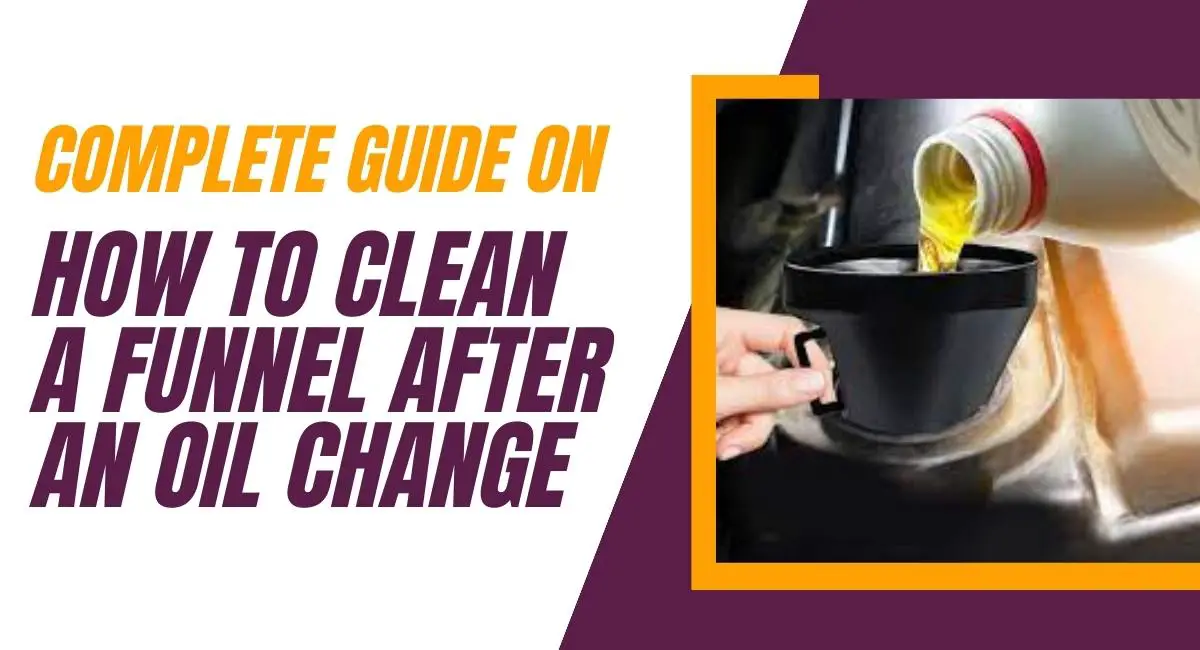As an automobile enthusiast or a DIY mechanic, you know that performing regular oil changes is essential for maintaining your vehicle’s engine health and longevity. However, while changing the oil is relatively straightforward, one often overlooked yet crucial step is cleaning the funnel used during the process.
You’ve not completed the process if you’ve successfully drained the old oil and replaced the filter. But now you’re ready to pour in the fresh golden elixir that will rejuvenate your engine, hold on! Remember that trusty funnel that guided the oil to its destination. Neglecting to clean the funnel after an oil change could lead to many problems!
That’s why this comprehensive guide is here to help. We will outline the importance of cleaning an oil funnel after an oil change and provide practical, step-by-step instructions on how to do it.
Understanding the Oil Change Process
Vehicle maintenance is critical to ownership, ensuring your engine runs smoothly and efficiently. During an oil change, a funnel is a vital tool. It guides the new clean oil into the engine and prevents spills that could lead to damage or mess. However, the importance of a clean oil funnel often needs to be noticed.
If you’ve used a funnel for an oil change, it’s bound to have residue. If you’ve used a funnel for an oil change, it’s bound to have residue. A clean oil funnel can make a difference, ensuring only pure oil enters your engine.
Why is it Important to Clean the Funnel After an Oil Change?
Cleaning your oil funnel after an oil change is paramount for several reasons.
Prevention of Cross-contamination
Leftover oil residue can mix with new oil the next time you use the funnel, leading to cross-contamination. T can compromise the quality of the new oil, affecting your engine’s performance and efficiency. A clean funnel ensures that the new oil isn’t contaminated, maintaining the integrity of the oil change.
Preservation of Funnel Integrity
Over time, oil residue can degrade the funnel material, mainly if made of plastic. It can lead to the funnel becoming brittle or forming cracks, potentially causing spills during an oil change or breaking mid-use. Regular cleaning maintains the funnel’s material integrity and ensures its longevity.
Avoidance of Debris
Oil residue can act as a sticky trap for dust, dirt, and other particulates, which can then get transferred to your engine during the following oil change. These particles can cause abrasive wear and tear in the engine, leading to efficiency loss or even mechanical damage over time.
Adherence to Best Maintenance Practices
Regularly cleaning your funnel is a good habit that aligns with overall best practices for vehicle maintenance. Clean tools help ensure more efficient and effective maintenance tasks.
Cleaning your oil funnel after an oil change is a simple yet critical step. It helps prevent cross-contamination of your engine oil, maintains the condition and longevity of the funnel, and is part of adhering to comprehensive and practical vehicle maintenance practices.

How to Clean a Funnel After an Oil Change
Cleaning a funnel after an oil change is a simple task that requires a few basic supplies and a little time. Here are the steps to do it effectively:
Materials Needed:
- A suitable solvent (like brake cleaner or degreaser)
- A cleaning brush
- Warm running water
- A clean, dry cloth
Steps to Clean an Oil Funnel:
- Empty the funnel: Drain all residual oil before cleaning.
- Rinse with a suitable solvent: Use a suitable brake cleaner or degreaser. Spray it inside the funnel and leave it to soak for a few minutes.
- Scrub the funnel: With a cleaning brush, scrub the funnel’s interior to remove the oil residue. Pay attention to corners and edges where oil might be trapped.
- Rinse thoroughly: Rinse the funnel thoroughly under warm running water to remove any remaining solvent or oil.
- Dry: Use a clean cloth to dry the funnel thoroughly, or leave it to air dry before storing it.
Remember, it’s critical to remove all oil residue to prevent future cross-contamination and ensure the tool’s longevity.
DIY Methods of Cleaning an Oil Funnel
Cleaning an oil funnel can be a simple DIY (Do It Yourself). Here are a few easy methods you can do at home:
Dish Soap and Warm Water Method
Materials: Dish soap, warm water, a scrub brush, and dry cloth.
Steps:
- Rinse the funnel out with warm water to remove any loose oil.
- Apply dish soap to your scrub brush and scrub the inside and outside of the funnel.
- Rinse again with warm water until all the soap is gone.
- Dry the funnel thoroughly using a clean cloth, or leave it to air dry.
Vinegar and Baking Soda Method
Materials include Vinegar, baking soda, a scrub brush, and dry cloth.
Steps:
- Rinse the funnel with warm water to remove any loose oil.
- Sprinkle baking soda inside and outside the funnel.
- Pour vinegar over the baking soda and allow it to fizz and react, helping to break down the oil.
- Scrub the funnel using your brush.
- Rinse thoroughly with warm water and dry completely before storing.
Brake Cleaner or Degreaser Method
Materials include a Brake cleaner or degreaser, a scrub brush, warm water, and a dry cloth.
Steps:
- Spray the funnel with brake cleaner or degreaser, ensuring all areas are covered.
- Let it sit for a few minutes, allowing the cleaner to break down the oil.
- Use a scrub brush to clean the inside and outside of the funnel.
- Rinse thoroughly with warm water and dry completely before storing.
Remember, safety comes first. Always wear gloves and protective eyewear when using chemicals like brake cleaners or degreasers, and work in a well-ventilated area.
These DIY methods are easy, cost-effective, and use materials typically available around the house. Choose the method that suits you best, and keep your oil funnel clean for each oil change. It helps maintain the integrity of the oil and contributes to the longevity of your vehicle’s engine.
Funnel Care Post Oil Change
Maintaining your oil funnel goes beyond just cleaning. To enhance the lifespan and efficiency of your funnel, follow these best practices:
Store it properly: Store it in a clean, dry place after cleaning and drying your oil funnel. It will prevent dust and other contaminants from settling on it.
Regular maintenance: Clean your oil funnel after every oil change to keep it in top shape. Regular cleaning prevents the buildup of oil residue.
Check for damage: Before each use, check your oil funnel for any damage. Cracks or holes in the funnel can lead to spills or oil contamination.
Should I Reuse An Oil Funnel?
Yes, an oil funnel can and should be reused, but cleaning it thoroughly after an oil change is crucial. Funnels are durable tools designed for repeated use; reusing them is cost-effective and environmentally friendly.
However, reusing an oil funnel without proper cleaning can lead to cross-contamination of engine oil, as residual oil left in the funnel can mix with the fresh oil during the following change. This contamination can compromise the effectiveness of the new oil and potentially impact your engine’s performance and efficiency.
Moreover, the leftover oil residue can degrade the funnel over time, mainly if it’s made of plastic, leading to brittleness or the formation of cracks. In severe cases, this can cause spills or breakage during an oil change.
Therefore, clean your oil funnel thoroughly after each use to safely and effectively reuse it. This cleaning should remove all oil residue and debris, leaving the funnel clean and ready for the following oil change.
In addition, before each use, inspect your funnel for any signs of damage, such as cracks or holes. If you find any damage, replacing the funnel is better to avoid potential spills or oil contamination.
Disposable Oil Funnels
While cleaning and maintaining your oil funnel is possible, you can invest in a disposable one. A disposable oil funnel is a convenient and practical tool designed for single-use application in activities such as oil changes.
These funnels have lightweight, cost-effective materials like thin plastic or cardboard. They are designed to be sturdy enough for single use but can dispose of afterward, eliminating the need for cleaning.
Features of a Disposable Oil Funnel:
- Material: Disposable oil funnels have lightweight materials like plastic or coated cardboard. The material is typically resistant to oil and other automotive fluids.
- Design: They come in various sizes and designs to accommodate different vehicles and oil change needs. Some disposable funnels are collapsible or flat-packed for easy storage and transportation.
- Use: They are designed for one-time use, offering a clean funnel each time you change the oil. This feature can be beneficial as it eliminates any risk of cross-contamination from previous oil changes.
- Disposal: The disposable oil funnel is discarded after use. It eliminates the need for cleaning, which can be a messy task.
- Convenience: Disposable oil funnels are incredibly convenient for quick oil changes, especially for those who do not want to clean and store a traditional funnel.
While disposable oil funnels can be convenient, it’s crucial to consider their environmental impact. They contribute to waste and can be less environmentally friendly than using a reusable funnel. Therefore, if you choose to use disposable funnels, it’s essential to dispose of them responsibly.
Important read: Why Does My Car Smell Like Onions? Exploring Solutions
Conclusion
Cleaning an oil funnel after an oil change cannot be emphasized enough. A clean oil funnel ensures the purity of oil entering your engine, contributing to efficient vehicle performance. Adherence to these steps and best practices will enhance the longevity of your tools and the efficiency of your vehicle maintenance tasks. So roll up those sleeves, and ensure your oil changes are conducted with the cleanest tools for the best results!
